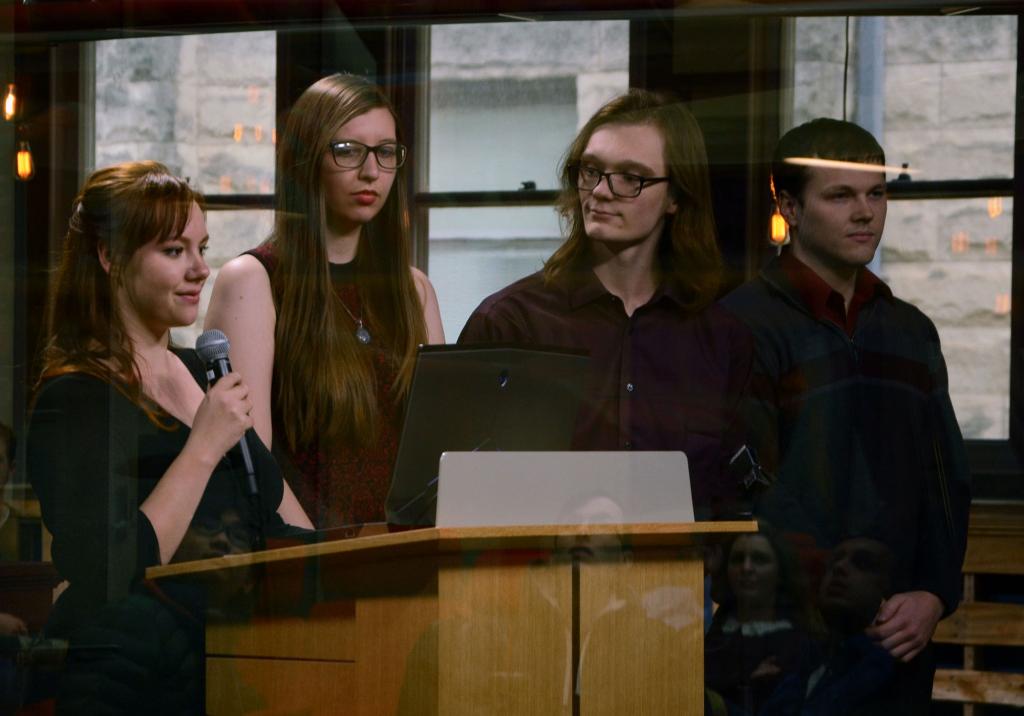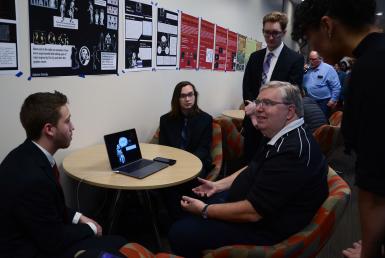5 games survive annual Shark Tank

An authoritarian ruler of the world. An earthling accountant captured by aliens to run a trading post in space. A festival-planning, community-building cat.
Five teams of game design students were selected to move forward after introducing these characters, and others, while pitching their games at Shark Tank, The Media School’s fifth annual game design pitch competition, Friday. The five selected games are:
- “Island Flight Courier”
- “Matter of Great Import”
- “New World Disorder”
- “The Shadows that Linger”
- “Woebegone Woods”
Student teams from the Production II and Design II classes shared their game prototypes with a public audience and a panel of industry experts who, with faculty, determined which projects will continue into the development stage. There were about 30 pitches earlier in the semester, said professor of practice Mike Sellers, director of the game design program, and Shark Tank is the final filter before the capstone course of the three-semester workshop.

“Pitching an original game is an important part of the game design process,” Sellers said. “It acts as something of a crucible for identifying and refining viable game concepts.”
Students whose games were not selected will be reassigned to the remaining teams.
This year’s industry experts were Ray Holmes, creative director at Babelfish Games; Dave Rohrl, CEO at Mobile Game Doctor; and Paul Stephanouk, senior creative director at King. The panel listened to each pitch, then asked follow-up questions and offered feedback.
The games that will move forward into development are:
Island Flight Courier
Take a relaxing flight through a dynamic world in “Island Flight Courier.” Players help a storm-ravaged island recover by using the plane’s grab-shot to grab, pull and transport island resources to help island inhabitants. Your mission: move items and collect all of the available resources to upgrade your plane, allowing you to better explore the island.
Matter of Great Import
“Matter of Great Import,” a 2D pixel game, plucks players from their uneventful lives as earthling accountants to run a galactic trading post. The player must make enough money to purchase a ride home by negotiating with alien clients, managing their station and making ends meet at all costs.
New World Disorder
In “New World Disorder,” you’re the authoritarian leader of Earth and have control over everything. Your task is to train a successor while fighting to maintain public approval. The game includes real-time threats that players must find and resolve.
The Shadows that Linger
“The Shadows that Linger” is a narrative-driven hidden objects game. In this murder mystery with a twist, players can speak with the supernatural, channel a crystal ball to reveal color and uncover dark secrets to ultimately solve a murder. The target audience for the game is players who are motivated by story and discovery.
Woebegone Woods
In “Woebegone Woods,” players have a unique opportunity: to kindle friendship in the cozy town of Woebegone Woods by planning the annual winter festival. Players act as Bean the Cat, aiming to finish assigned planning tasks and receive positive feedback from friends.
The other pitches were:
Beat Skater
Want to feel the nostalgia of the early-2000s skateboarding era? In “Beat Skater,” players endlessly skateboard from a skater’s perspective. The game uses swipe and touch finger motions to mimic feet on a skateboard ride. As players progress, they can customize boards and environments in the game, unlock new tricks, complete daily and weekly challenges, and compete in player leaderboards.
Crown of Bone
In “Crown of Bone,” players take the role of a deer, designing their own antlers to help other animals. You can explore the forest and fight other deer, working toward the ultimate goal of achieving the distinguished position of King of the Forest.
Monty
Play as the recently imprisoned Gummi Bear Prince Monty in a dark candy world in “Monty.” The player’s objective, with the help of new gummi followers and their unique gummi abilities, is to escape the candy dungeon and reclaim the kingdom.

